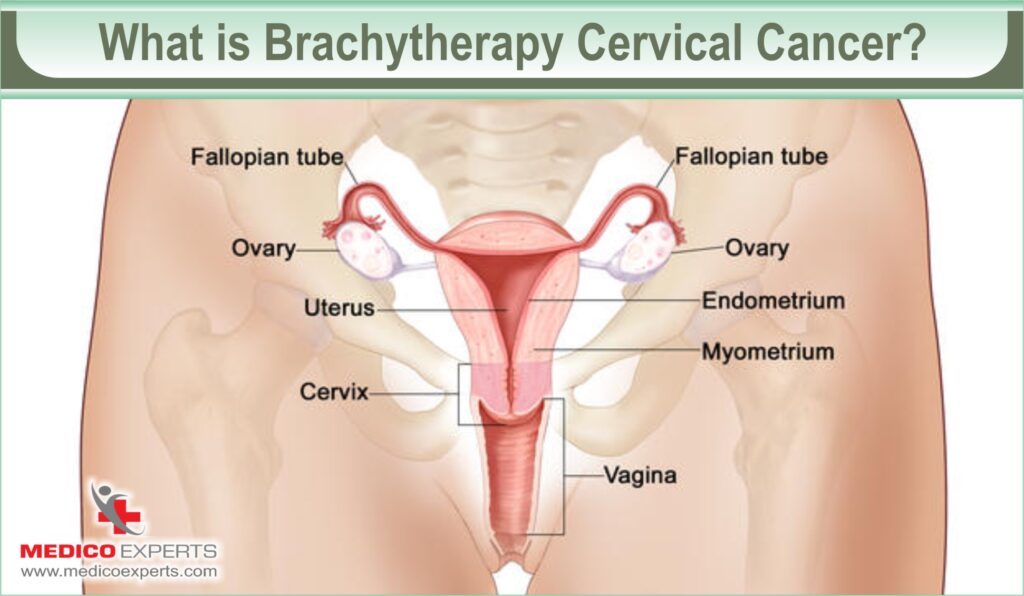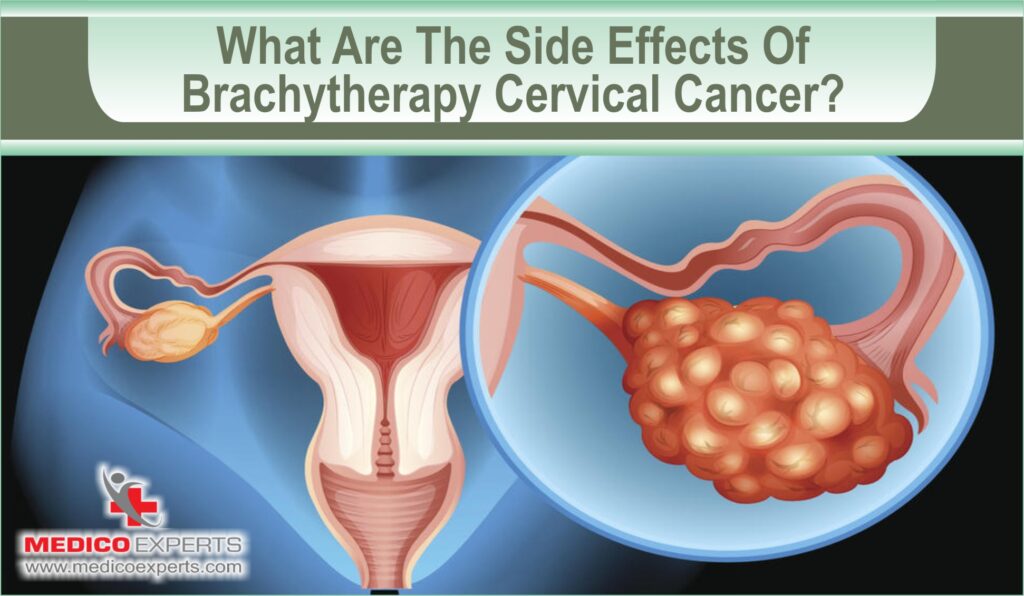Understand why brachytherapy may be the preferred treatment option for cervical cancer and what to expect when undergoing it.
Brachytherapy is an important treatment option for many types of cervical cancers. It uses radiation to target and destroy the affected tissue while sparing normal tissue surrounding it.
In many cases, it is used in conjunction with other therapies like as chemotherapy or surgery.
When considering brachytherapy for cervical cancer, it is important to understand both its potential benefits and the possible side effects associated with the procedure. Keep reading to find out more about brachytherapy for cervical cancer.
MedicoExpert’s Tumor Board is the right place to discuss brachytherapy cervical cancer and other related topics. Read more now!
What is Brachytherapy Cervical Cancer?

Brachytherapy, also known as internal radiation therapy or sealed source radiotherapy, is a type of treatment used to treat cervical cancer. Small radiation sources, such as seeds, capsules, or ribbons, are inserted into or near the tumor in your body.
This type of treatment is limited to a particular area and is commonly employed to treat cancers of regions such as the breast, cervix, head, prostate, eye, and neck.
Radiation therapy aims to give the cancer a healing amount of radiation, without harming normal nearby organs like the rectum, bowel, and bladder. This reduces the risk of complications.
Both brachytherapy and external beam radiation therapy are used in the treatment of patients who have cancer of the cervix.
Let’s examine the distinction more closely.
The Difference Between Brachytherapy and External Beam Radiation Therapy.

The treatment known as external beam radiation therapy (EBRT) involves using a machine to direct radiation toward the tumor site. This method is referred to as external because the source of the radiation is located outside of your body.
EBRT, which is a painless treatment, usually takes a few minutes and is administered over multiple outpatient visits. The number of visits required will depend on your unique treatment plan. Cervical cancer treatment frequently involves combining EBRT with other treatments, including chemotherapy and brachytherapy.
For certain individuals with cervical cancer, such as those who cannot undergo chemotherapy or those who choose not to have surgery, EBRT may be considered as the main treatment option.
How Does Brachytherapy Cervical Cancer Work?

It involves placing radioactive sources inside or near the tumor to deliver radiation directly into the affected area.
This can decrease the amount of healthy tissue that needs to be exposed and helps reduce side effects associated with traditional external beam radiation therapy. Cervical cancer can often be treated with brachytherapy alone, though it may be part of a larger course of treatment including surgery and chemotherapy.
The size and location of the tumour are two of the numerous criteria that play a role in determining where the radiation sources should be placed. The brachytherapy procedure itself is usually done under general anesthesia with a CT scan to ensure precise placement.
Interstitial brachytherapy is one way in which radioactive sources can be placed directly into or around tumors, while High Dose Rate (HDR) brachytherapy involves placing temporary sources within the tissue. Both methods are effective for treating cervical cancer, though HDR is often used if there is a larger tumor or if more radiation dose needs to be delivered quickly.
What Are The Side Effects Of Brachytherapy Cervical Cancer?

Side effects of brachytherapy vary depending on the dose and type of radiation used.
Common side effects may include:
- fatigue,
- nausea,
- hot spots where the radiation sources were placed,
- The therapy causes changes in the skin in the affected region, and
- increased sensitivity to sunlight.
Most of these side effects are temporary and can be managed with medication or rest. It is important to talk to your doctor about any symptoms that develop during or after brachytherapy so they can be addressed promptly.
In rare cases, brachytherapy may cause long-term side effects such as infertility or secondary cancers. This should be discussed with your doctor before treatment begins so you understand any risks associated with this type of therapy.
How to deal with the temporary side effects of brachytherapy.
The side effects of brachytherapy are usually temporary and will go away within a few weeks after your treatment. Here are some helpful tips for managing them:
- Rest up.
If you’re feeling tired, make sure to rest adequately. Aim for 8 hours of sleep per night and avoid pushing yourself too hard.
- Be kind to your skin.
To avoid worsening vaginal or vulva irritation, it’s best to stay away from personal care items that could cause more irritation, like some types of soaps and bubble baths. To help ease irritation, wearing undergarments that are loose and breathable is also beneficial.
- Drink plenty of water.
Drinking enough water can prevent dehydration caused by vomiting or diarrhea, and it can also alleviate bladder irritation.
- Consider food.
If you have an upset stomach with symptoms like nausea, vomiting or diarrhea, it is best to stay away from foods that can cause more irritation to your digestive system.
- Ask about medications.
If you experience side effects such as discomfort, diarrhea, or nausea there are medications that can help manage them. To learn more about medication options, it’s best to discuss them with your care team.
What are the possible hazards and adverse effects of undergoing brachytherapy?

Long-term side effects or complications may occur with radiation therapies such as brachytherapy, and these can manifest months to years after treatment.
Some of these effects may include:
- Vaginal Dryness.
Exposure to radiation can cause the lining of the vagina to become dry, which may result in pain during sexual activity.
- Vaginal Stenosis.
Vaginal stenosis is a medical condition in which scar tissue causes the vagina to become narrower and reduces its ability to stretch.
- Radiation Cystitis.
Chronic irritation of the bladder may result from exposure to radiation, which can cause symptoms such as pelvic pain, blood in the urine, and frequent urination.
- Rectal Stenosis.
Having difficulty or pain while passing stools can be a result of rectal stenosis, where the rectum is narrowed.
- Lymphedema.
The condition known as lymphedema causes swelling in the leg due to the improper drainage of lymph fluid.
If you are having any issues related to brachytherapy, it’s important to see your doctor. They can collaborate with you to create a strategy for dealing with symptoms.
How Successful Is Brachytherapy For Cervical Cancer?

Brachytherapy is an effective treatment for cervical cancer and has been found to have a high success rate in clinical studies.
It can be used alone or in combination with other therapies, such as surgery and chemotherapy, to help maximize your chances of survival and reduce the risk of recurrence. Your doctor will discuss the best course of action for you based on your individual needs.
A recent study compared the treatment effectiveness of cervical cancer with and without brachytherapy and found that adding brachytherapy improved patient survival at the 5-year mark. The survival rate was 54% with brachytherapy and 42% without brachytherapy.
Once the brachytherapy procedure is complete, it is important to follow up with your doctor regularly for check-ups and tests. This allows them to monitor any changes in your health and catch any signs of a recurrence early so that further treatment can be started quickly.
Overall, brachytherapy is a safe and effective way to treat cervical cancer and can provide good outcomes for those living with this disease. Medicoexpert Tumor Board is here to help you understand the basics of brachytherapy and answer any questions you may have.
Learn about the advantages of brachytherapy here…
Conclusion
Brachytherapy is a form of radiation therapy that is specifically utilised in the treatment of cervical cancer. It works by inserting a radioactive material into an implant that is placed near the tumor. The radiation used in brachytherapy only travels a short distance from the source and once the radiation source has been removed from the implant, it is safe to be around other people, including family and friends.
The duration of implant placement in brachytherapy varies depending on the specific type of treatment and your personalized plan. Your doctor will inform you of the exact timeline. Though the side effects of brachytherapy are usually temporary, they can be controlled with medicine and lifestyle adjustments.
However, some individuals may experience long-term complications, so it is essential to contact your doctor promptly if you suspect any complications from brachytherapy.
MedicoExperts Tumor Board recommends discussing the risks and benefits of this treatment with our team before making any decisions. With adequate information, you can make an informed decision that best suits your individual needs.
Our team is here to help you find the best solution for your specific diagnosis. Contact us today to learn more about brachytherapy and other treatments available for cervical cancer.
We hope this article has provided helpful background information on brachytherapy for cervical cancer and how it can be used effectively in combination with other treatments.
Thanks for reading!
FAQ :
Q. How many sessions of brachytherapy are needed for treating cervical cancer?
A. Typically, 3-4 sessions of brachytherapy are required over a period of 2-4 weeks.
Q: What happens after undergoing brachytherapy?
A: Following completion of your brachytherapy treatment, your healthcare team will request you to return to the hospital for regular check-ups to ensure you receive adequate treatment and support.
Q. Can brachytherapy be used as a permanent treatment option?
A. Brachytherapy involves placing radioactive material inside the patient’s body as a form of treatment. The duration of treatment can vary from several minutes to several days, but it can also be permanent.
Q. For whom is brachytherapy recommended?
A. Brachytherapy is recommended for individuals with a prostate tumor that is limited to the prostate gland and has a low chance of spreading to other parts of the body. Additionally, patients with intermediate or high-risk prostate cancer are good candidates for brachytherapy treatment.
Q. Can you list the three types of brachytherapy?
A. There are three methods of brachytherapy: intracavitary treatment, interstitial treatment, and unsealed internal radiation therapy. Reach out to MedicoExperts Tumor Board for more information. Speak to us today!



